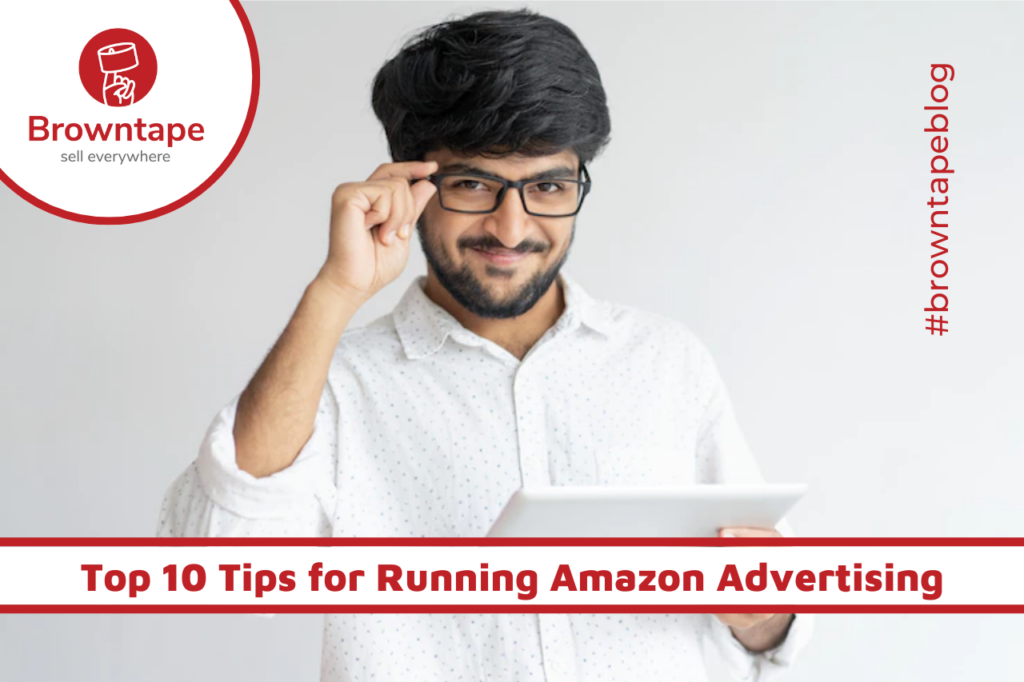Top 10 Tips for Running Amazon Advertising

Since its inception in 1994, Amazon has grown at an exponential rate. With the 9.7 million sellers & around 197 million monthly customers, it’s safe to say that Amazon’s growth will continue unabated. As a result, in addition to the convenience of the online shopping, many people prefer to purchase on Amazon.
To be an Amazon seller is indeed a low-risk, high-reward business, but you must play your cards carefully. Although every business goes through a period of trial and error, you don’t want to waste valuable money, effort, and time trying to fix your mistakes.
Marketing campaigns are one way to expand your Amazon PPC business. When done correctly, these campaigns can reach more customers and even get them to buy your products.
While it is simple to set up an Amazon store, gaining exposure takes time. It’s difficult to get the exposure needed to generate sales when there are so many sellers competing for the same product. As a result, leveraging your store with Amazon advertising campaigns is your best bet for selling on Amazon as quickly as possible.
To run at their best, Amazon campaigns, like other advertising campaigns, involve technical knowledge and expertise. Continue reading for ten tips on how to improve Amazon advertising.
How to go About?
1. Optimize the Listings Properly

Despite this, some sellers ignore the above. If you’re new to Amazon advertising or Amazon PPC campaigns, you should know that the entire concept is based on the product page listings. Your listings should include all of the relevant keywords, and also descriptions, images, and video content.
The visuals must follow the Amazon’s guidelines, and the reports must be accurate. One can use a product database tool to save the processes and achieve that everything you included in the listings is complete and accurate.
Because they don’t believe it’s necessary, some sellers do not even spend much time completing or optimising their listings. Nevertheless, this is the simplest strategy for boosting the visibility of your listings.
Furthermore, you can use it as a cornerstone to properly run your advertisements on the platform in the future.
2. Make Your Brand More Visible by Using Sponsored Brands.
Amazon sellers who are unfamiliar with the various types of ads on the site may mix them up. On the platform, there are three types of ads: product display ad-sponsored brand ad, and sponsored product ad. Sponsored brands are one of the best Amazon Advertisements type to use if you’re a new brand that still needs recognization from consumers. Assume you ran a PPC campaign on Amazon for the keyword “earphones.” This keyword will be used by the user to search Amazon for earphones. Because you used this keyword in the sponsored brand awareness post, your product ad would then appear as a banner at the top of the page, complete with the logo, headline, and the selected products.
This not only improves a product’s performance on individual listings, but also draws attention to your brand. Increased brand awareness among the target customers will result from increased brand visibility.
3. Run Automated and Manual Marketing Ads

The automated ads are indeed easier to set up, particularly if this is your first time running an ad campaign, you should still run manual campaigns on occasion.
When it comes to finding keywords to target manually, automated ads provide a wealth of information. Manual campaigns, on the other hand, allows you to specify which precise keywords you would like to target and bid on. You can optimise targeting others with higher conversion rates because you’re in charge of deciding the bid per keyword. Most beginners and those who have never run an Amazon ad are apprehensive about running the manual campaigns, which itself is understandable.
Run automated ads with general key words and phrases you would like to target first to ease yourself into it. Determine which are converting as well as use them to launch your next manual campaign. This way, you can use automated campaigns to find the best keywords while manual campaigns increase reach and conversions.
4. Restrict ads from showing in Irrelevant Searches
Amazon advertising, like AdWords, allows users to use negative keywords to “block” ads from appearing for specific searches. If you sell flat sandals but not tennis shoes, for example, you could indeed add tennis shoes as a negative search term to prevent ads from displaying when people search for tennis shoes. As a result, if a user searches for flat sandals, they will find your ad, but not if they search for tennis shoes.
Negative keywords, when used correctly, can help save money and increase conversion rates by displaying your Amazon Advertising to more qualified users. You could use match types to negative keywords to generate negative word matches and significant exact match keywords to further refine your campaigns.
The same rules apply to regular match types.
As a result, if you’re using a negative phrase match for grey shoes, your ad will not show up for searches like small grey shoes or grey shoes 10. You can build your negative keyword list over time, but if you do have relevant keywords for that you must not appear, you as a seller could indeed add them without seeing any performance results. Check the search report on a regular basis to see if there would be any more keywords which should be excluded.
5. Category – Specific Targeting

Sponsored Products appear on the right-hand side, above, and below Amazon search results (depending on their position). You can use this ad feature to target specific categories in order to pair your product with products that are similar and complementary to it. The goal is to increase sales conversions by combining different products that satisfy each other.
Product Attribute Targeting (PAT) is a feature that allows brands to promote a product based on its type, price point, or placement alongside related brands. This method, when used as a strategy, enables users to emphasise the product alongside similar-priced items and by pairing it with complementary items.
As a strategy, this methodology enables you to showcase the product alongside similar-priced items and by pairing it with complementary items. If you sell exercise gear, for example, trying to run sponsored product ads would then pair your product with all kinds of crossover product lines like workout clothes, footwear, and more on search result pages. You must first establish manual targeting throughout the sponsored product campaign before running a PAT ad.
After that, you must choose the brands and bids you would like to use before deciding which product categories to target.
Finally, you target well-known brands with equivalent price levels or ratings, enabling you to capitalise on their popular appeal as well as position your product alongside theirs in similar search results. The beauty of this strategic plan is that, this will give the product the impactful push that comes from appearing in similar product searches without requiring you to spend a lot of money on costly ad campaigns.
6. Optimize the Bids
You should review your keywords every couple of weeks and determine which are the most effective. However, don’t make a hasty decision to change your keyword strategy based on the most recent data. Keywords and phrases are subject to change over time. One‘s popularity, as well as usage, could be influenced by something in pop culture, or even the market volatility for your product could have an ebb and flow.
Assume you believe one or two phrases are outliers and underperformers. You can include it in your campaign in that case, but don’t go crazy and start changing every key based on a two-week performance.
Rather, use Automatic Targeting to find out what terms your customers have been using recently and then test the new phrase. If it keeps performing well, you can tweak your product descriptions to match, iterate your ads to match the new search queries, and drop the terms that aren’t working.
This step, once again, is critical and should be taken slowly. Set up a test, give it a few days to see if it’s useful, then run an iterated (tweaked) version to see if usage rises or falls. Recognize the Amazon advertising purpose as a best practise because it eliminates a lot of the risk and experimentation associated with trial-and-error.
7. Establish Sufficient Daily Budgets

While Google search engine and other Amazon PPC algorithms may penalise or reward you based on your budget, Amazon merely uses it to reach a maximum budget before turning off your ads. There is no hidden benefit to increasing your budget if it is adequate to sustain your bids. There’s no reason to stop sending traffic to your listings if you have enough inventory. If your ACoS (Acquired Cost of Sale) is low, it’s recommended to set it as high as you can.
8. Within a Single Ad Group, Variations can be Placed
If your products come in different sizes, colours, or flavours, it’s a good idea to group them together in Ad Groups. The image will be displayed in the ad, and traffic will be directed to some of the most popular variations. When a consumer lands here on detail page, they could choose from any of the available options. If a customer enters additional search terms particular to a single variation (for example, a colour), Amazon will display that variance on the search results page and provide a link to a certain selection here on the detail page.
9. Organize Your Advertisements Correctly
Begin creating an advertisement for every group of products that have keywords in common. Then, using Ad Groups, you can target various match types. (Each Campaign, for example, may well have three advertisement groups: broad, phrase, and the exact.) You’ll only have to create one Ad Format for all of the products that have similar keywords for Automatic Campaigns. Make sure to include listings for Fulfilled by Merchant and FBA in each advertisement so that your advertisements continue running regardless of which fulfilment methods are active at the time.
10. Cancel the Ineffective Ad Campaigns
Now that you’ve reviewed the data for your top-performing ad terms, it’s time to turn off the ones that aren’t working. Monitoring which keywords appear to be performing well and which appear to be underperforming is only the first step in your optimization strategy.
You should also think about which products aren’t selling or aren’t performing well. When a product requires a lot of advertising to make one sale, you should think about whether it’s worth selling. If the return and profit margin are low, consider discontinuing the product or considering it as a potential upsell instead of a devoted product with a marketing budget that diverts funds from better-performing products.
Final Thoughts
For many eCommerce retailers, Amazon Advertising is an important part of their digital strategy. Because of Amazon’s size as well as popularity among customers, generating sales on the platform is not only a must, but also a requirement for retailers seeking to expand their businesses.
The most expedient option for resellers who would like to increase exposure for their Amazon store is to use customers through Amazon advertising. While this process takes a lot of time and effort, the return on investment in terms of new customers is well worth it.
